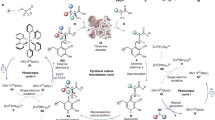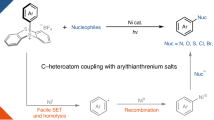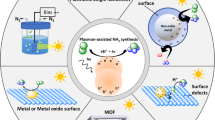Abstract
Light can be considered an ideal reagent for environmentally friendly, 'green' chemical synthesis; unlike many conventional reagents, light is non-toxic, generates no waste, and can be obtained from renewable sources. Nevertheless, the need for high-energy ultraviolet radiation in most organic photochemical processes has limited both the practicality and environmental benefits of photochemical synthesis on industrially relevant scales. This Perspective describes recent approaches to the use of metal polypyridyl photocatalysts in synthetic organic transformations. Given the remarkable photophysical properties of these complexes, these new transformations, which use Ru(bpy)32+ and related photocatalysts, can be conducted using almost any source of visible light, including both store-bought fluorescent light bulbs and ambient sunlight. Transition metal photocatalysis thus represents a promising strategy towards the development of practical, scalable industrial processes with great environmental benefits.
This is a preview of subscription content, access via your institution
Access options
Subscribe to this journal
Receive 12 print issues and online access
$259.00 per year
only $21.58 per issue
Buy this article
- Purchase on Springer Link
- Instant access to full article PDF
Prices may be subject to local taxes which are calculated during checkout




Similar content being viewed by others
References
Morton, O. Silicon Valley sunrise. Nature 443, 19–22 (2006).
Nocera, D. G. On the future of global energy. Daedalus 135, 112–115 (2006).
Lewis, N. S. Toward cost-effective solar energy use. Science 315, 798–801 (2007).
Roth, H. D. The beginnings of organic photochemistry. Angew. Chem. Int. Ed. Engl. 28, 1193–1207 (1989).
Albini, A. & Fagnoni, M. Green chemistry and photochemistry were born at the same time. Green Chem. 6, 1–6 (2004).
Albini, A. & Fagnoni, M. 1908: Giacomo Ciamician and the concept of green chemistry. ChemSusChem 1, 63–66 (2008).
Ciamician, G. The photochemistry of the future. Science 36, 385–394 (1912).
Fagnoni, M., Dondi, D., Ravelli, D. & Albini, A. Photocatalysis for the formation of the C–C bond. Chem. Rev. 107, 2725–2756 (2007).
Protti, S. & Fagnoni, M. The sunny side of chemistry: Green synthesis by solar light. Photochem. Photobiol. Sci. 8, 1499–1516 (2009).
Oelgemöller, M., Jung, C. & Mattay, J. Green photochemistry: Production of fine chemicals with sunlight. Pure Appl. Chem. 79, 1939–1947 (2007).
Esser, P., Pohlmann, B. & Scharf, H.-D. The photochemical synthesis of fine chemicals with sunlight. Angew. Chem. Int. Ed. Engl. 33, 2009–2023 (1994).
Lewis, N. S. & Nocera, D. G. Powering the planet: Chemical challenges in solar energy utilization. Proc. Natl Acad. Sci. USA 103, 15729–15735 (2006).
Balzani, V., Credi, A. & Venturi, M. Photochemical conversion of solar energy. ChemSusChem 1, 26–58 (2008).
Kalyanasundaram, K. Photophysics, photochemistry, and solar energy conversion with tris(bipyridyl)ruthenium(II) and its analogues. Coord. Chem. Rev. 46, 159–244 (1982).
Juris, A., Balzani, V., Barigelletti, F., Campagna, S., Belser, P. & von Zelewsky, A. Ru(II) polypyridine complexes: Photophysics, photochemistry, electrochemistry, and chemiluminescence. Coord. Chem. Rev. 84, 85–277 (1988).
Kalyanasundaram, K. in Photochemistry of Polypyridine and Porphyrin Complexes 339–368 (Academic Press, 1992).
Ischay, M. A., Anzovino, M. E., Du, J. & Yoon, T. P. Efficient visible light photocatalysis of [2+2] enone cycloadditions. J. Am. Chem. Soc. 130, 12886–12887 (2008).
Nicewicz, D. A. & MacMillan, D. W. C. Merging photoredox catalysis with organocatalysis: The direct asymmetric alkylation of aldehydes. Science 3 22, 77–80 (2008).
Cano-Yelo, H. & Deronzier, A. Photocatalysis of the Pschorr reaction by tris-(2,2′-bipyridyl)ruthenium(II) in the phenanthrene series. J. Chem. Soc. Perkin Trans. 2 1093–1098 (1984).
Cano-Yelo, H. & Deronzier, A. Photo-oxidation of some carbinols by the Ru(II) polypyridyl complex-aryl diazonium salt system. Tetrahedron Lett. 2 5, 5517–5520 (1984).
Zen, J.-M., Liou, S.-L., Kumar, A. S. & Hsia, M.-S. An efficient and selective photocatalytic system for the oxidation of sulfides to sulfoxides. Angew. Chem. Int. Ed. 42, 577–579 (2003).
Burstall, F. H. Optical activity dependent on co-ordinated bivalent ruthenium. J. Chem. Soc. 173–175 (1936).
Demas, J. N. & Crosby, G. A. Quantum efficiencies on transition metal complexes. II. Charge-transfer luminescence. J. Am. Chem. Soc. 93, 2841–2847 (1971).
Kalyanasundaram, K., Kiwi, J. & Grätzel, M. Hydrogen evolution from water by visible light, a homogeneous three component test system for redox catalysis. Helv. Chim. Acta 61, 2720–2730 (1978).
Brown, G. M., Brunschwig, B. S., Creutz, C., Endicott, J. F. & Sutin, N. Homogeneous catalysis of the photoreduction of water by visible light. Mediation by a tris(2,2′-bipyridine)ruthenium(II)-cobalt(II) macrocycle system. J. Am. Chem. Soc. 101, 1298–1300 (1979).
Crimmins, M. T. Synthetic applications of intramolecular enone-olefin photocycloadditions. Chem. Rev. 88, 1453–1473 (1988).
Bach, T. Stereoselective intermolecular [2+2]-photocycloaddition reactions and their application in synthesis. Synthesis 683–708 (1998).
Baik, T.-G., Luiz, A. L., Wang, L.-C. & Krische, M. J. A diastereoselective metal-catalyzed [2+2] cycloaddition of bis-enones. J. Am. Chem. Soc. 123, 6716–6717 (2001).
Roh, Y., Jang, H.-Y., Lynch, V., Bauld, N. L. & Krische, M. J. Anion radical chain cycloaddition of tethered enones: Intramolecular cyclobutanation and Diels−Alder cycloaddition. Org. Lett. 4, 611–613 (2002).
Yang, J., Felton, G. A. N., Bauld, N. L. & Krische, M. J. chemically induced anion radical cycloadditions: Intramolecular cyclobutanation of bis(enones) via homogeneous electron transfer. J. Am. Chem. Soc. 126, 1634–1635 (2004).
Fournier, F. & Fournier, M. Transferts d'électrons assistés par les métaux de transition: influence de la nature du cation métallique sur la réduction de composés carbonylés en milieu aprotique. Can. J. Chem. 64, 881–890 (1986).
House, H. O., Huber, L. E. & Umen, M. J. Empirical rules for estimating the reduction potential of α, β-unsaturated carbonyl compounds. J. Am. Chem. Soc. 94, 8471–8475 (1972).
Du, J. & Yoon, T. P. Crossed intermolecular [2+2] cycloadditions of acyclic enones via visible light photocatalysis. J. Am. Chem. Soc. 131, 14604–14605 (2009).
MacMillan, D. W. C. The advent and development of organocatalysis. Nature 455, 304–308 (2008).
Beeson, T. D., Mastracchio, A., Hong, J., Ashton, K. & MacMillan, D. W. C. Enantioselective organocatalysis using SOMO activation. Science 3 16, 582–585 (2007).
Nagib, D. A., Scott, M. E. & MacMillan, D. W. C. Enantioselective α-trifluoromethylation of aldehydes via photoredox organocatalysis. J. Am. Chem. Soc. 131, 10875–10877 (2009).
Slinker, J. D. et al. Efficient yellow electroluminescence from a single layer of a cyclometalated iridium complex. J. Am. Chem. Soc. 1 26, 2763–2767 (2004).
Flamigni, L., Barbieri, A., Sabatini, C., Ventura, B. & Barigelletti, F. Photochemistry and photophysics of coordination compounds: Iridium. Top. Curr. Chem. 281, 143–203 (2007).
Hagmann, W. K. The many roles for fluorine in medicinal chemistry. J. Med. Chem. 51, 4359–4369 (2008).
Purser, S., Moore, P. R., Swallow, S. & Gouverneur, V. Fluorine in medicinal chemistry. Chem. Soc. Rev. 37, 320–330 (2008).
Zeitler, K. Photoredox catalysis with visible light. Angew. Chem. Int. Ed. 4 8, 9785–9789 (2009).
Narayanam, J. M. R., Tucker, J. W. & Stephenson, C. R. J. Electron-transfer photoredox catalysis: Development of a tin-free reductive dehalogenation reaction. J. Am. Chem. Soc. 131, 8756–8757 (2009).
Tucker, J. W., Narayanam, J. M. R., Krabbe, S. W. & Stephenson, C. R. J. Electron transfer photoredox catalysis: Intramolecular radical addition to indoles and pyrroles. Org. Lett. 12, 368–371 (2010).
Koike, T. & Akita, M. Photoinduced oxyamination of enamines and aldehydes with TEMPO catalyzed by [Ru(bpy)3]2+. Chem. Lett. 38, 166–167 (2009).
Ferrere, S. & Gregg, B. A. Photosensitization of TiO2 by [FeII(2,2′-bipyridine-4,4′-dicarboxylic acid)2(CN)2]: Band selective electron injection from ultra-short-lived excited states. J. Am. Chem. Soc. 120, 843–844 (1998).
Green, O., Gandhi, B. A. & Burstyn, J. N. Photophysical characteristics and reactivity of bis(2,9-di-tert-butyl-1,10-phenanthroline)copper(I). Inorg. Chem. 48, 5704–5714 (2009).
Acknowledgements
Research concerning the photocatalytic [2+2] cycloadditions described in this Perspective was supported by a Research Corporation Cottrell Scholar Award, a Beckman Young Investigator Award, and a Fellowship from the Sloan Foundation.
Author information
Authors and Affiliations
Corresponding author
Rights and permissions
About this article
Cite this article
Yoon, T., Ischay, M. & Du, J. Visible light photocatalysis as a greener approach to photochemical synthesis. Nature Chem 2, 527–532 (2010). https://doi.org/10.1038/nchem.687
Published:
Issue Date:
DOI: https://doi.org/10.1038/nchem.687
This article is cited by
-
Cage escape governs photoredox reaction rates and quantum yields
Nature Chemistry (2024)
-
Directional multiobjective optimization of metal complexes at the billion-system scale
Nature Computational Science (2024)
-
Direct allylic acylation via cross-coupling involving cooperative N‑heterocyclic carbene, hydrogen atom transfer, and photoredox catalysis
Nature Communications (2023)
-
Turning sulfonyl and sulfonimidoyl fluoride electrophiles into sulfur(VI) radicals for alkene ligation
Nature Communications (2023)
-
Formation and degradation of strongly reducing cyanoarene-based radical anions towards efficient radical anion-mediated photoredox catalysis
Nature Communications (2023)



